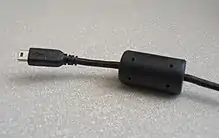Unintentional radiator
An unintentional radiator or incidental radiator is any device which creates radio frequency energy within itself, which is then unintentionally radiated from the device.[1] This can interfere with other electronic devices.
Example radiating devices
A computer is a typical example, where spurious emissions may not be contained within the case.
A radio receiver will often use an intermediate frequency which is detectable outside the radio—the concept behind at least one audience measurement concept for roadside detection of radio stations which passing motorists are listening to.
Other examples include the motor, transformer, dimmer, and corona from electrical powerlines. Unintentional radiation from these devices can create interference on AM radio, and on the video of television stations.
Regulatory overview
In North America, active devices that are characterized as "unintentional radiators" are governed by Part 15 of the FCC regulations. In Canada, Innovation, Science and Economic Development considers them as interference-causing Equipment. Globally, most domestic regulation of unintentional radiators are based on ITU recommendations.
Generally, this means the device leaks a signal at some level. Microprocessor-controlled appliances, anything with a clock signal, and switching voltage regulators all make some kind of noise, at the repetition frequency and at harmonics. In most countries, government agencies regulate how much leakage is tolerated. This prevents leakage from cable television systems, for example, from interfering with radio communications between aircraft and control towers.
Because it costs money to filter out noise, there is always a balance struck between regulatory compliance and perfect filtering in these devices. Microwave ovens or devices with microprocessors may leak within allowable limits but may generate an undesired signal that interferes with a licensed communications device. It also generally means that users who intentionally radiate signals (TV stations and cell phone companies) can order the device turned off if it interferes with their licensed operations.

There is an entire industry based on regulatory compliance: manufacturers shipping a product to a foreign country must comply with each country's limitations on leakage of interfering signals. For example, in Germany the TÜV issues regulatory rules for unintentional radiators. The big cylindrical bumps on the cable to monitors and laptop chargers are ferrite cores which reduce undesired signals.